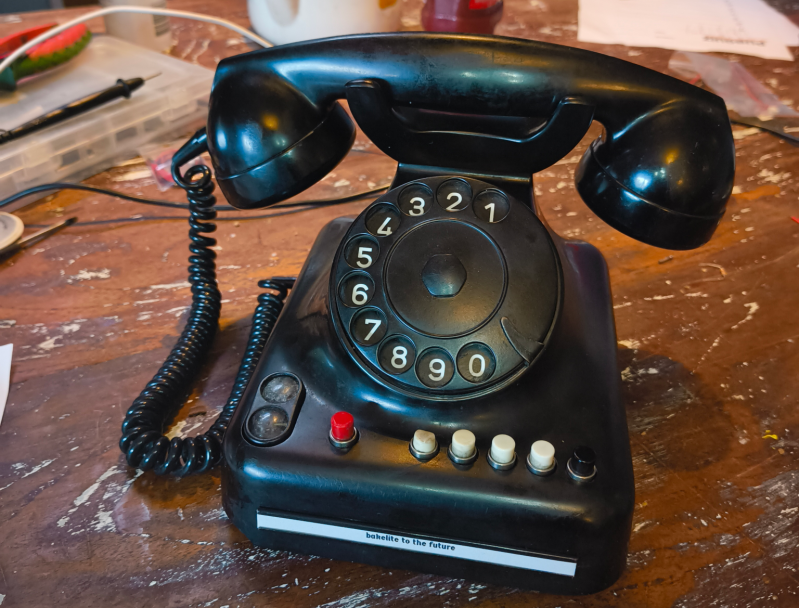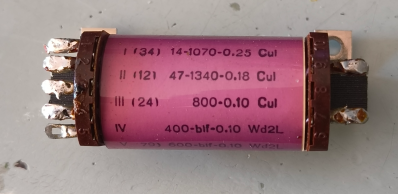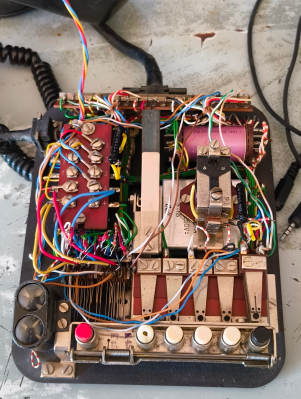
A decade ago, [Jouke Waleson] bought a Dutch ‘model 1950’ PTT (The Dutch Postal Service) rotary-dial telephone of presumably 1950s vintage manufactured by a company called Standard Electric, and decided it would be neat to hack it to function as a Bluetooth hands-free device. Looking at the reverse, however, it is stamped “10.65” on the bottom, so maybe it was made as recently as 1965, but whatever, it’s still pretty old-tech now.

The plan was to utilise ESP32 hardware with the Espressif HFP stack to do all the Bluetooth heavy lifting. [Jouke] did find out the hard way that this is not a commonly-trodden path in hackerland, and working examples and documentation were sparse, but the fine folks from Espressif were on hand via GitHub to give him the help he needed. After ripping into the unit, it was surprisingly stuffed inside there. Obviously, all the switching, even the indication, was purely electromechanical, which should be no surprise. [Jouke] identified all the necessary major components, adding wires and interfacing components as required, but was a bit stumped at the function of one funky-looking component that we reckon must be a multi-tap audio transformer, oddly finished in baby pink! After renovating some interesting cross-shaped mechanical indicators and wiring up some driving transistors, it was time to get on to the audio interface.
Initially, [Joike] planned to use an INMP441 I2S digital microphone module, but this was incompatible with the standard ESP32 HFP client (used for Bluetooth hands-free support), so [Jouke] pivoted and used a WM8782-based ADC board for audio input. This also allowed the existing microphone to be used simply by biasing

it to 5 Volts and hooking it straight up to the ADC board via a coupling capacitor. This was a happy outcome, as the modern digital microphone would have sounded very different to the original equipment! On the speaker side, a PCM5102 I2S audio DAC module was pressed into service. The ringer/buzzer needed seven volts, so adding a boost converter board was also necessary. It’s a minor annoyance for powering a single device, but this is a one-off hack, so it’s no big deal. Finally, the backplate was modified to add a USB-C module and a power switch so it could be power-cycled, giving access to the ESP32 boot loader and enabling firmware updates without opening the case.
The outfit’s brains are courtesy of a LilyGo T-Koala board, a basic breakout board based around the older ESP32-WROVER module. This was necessary as the newer ESP32 chips drop Bluetooth classic support and, with it, support for handling the Bluetooth hands-free protocol. We were particularly ticked by the project tagline, “Bakelite to the future”, and that lifting the phone when not answering an incoming call connects you to Google Assistant or Siri! Nice work! For a look over the source code for the project, check out the GitHub page.
This is not the first modernisation of a classic telephone, and we hope it won’t be the last. Here’s an older GSM-based hack. If all this talk of rotary phones and tethered handsets confuses you, here’s our guide to this older telephone system. Telephones weren’t the only old-school home appliances constructed from Bakelite—far from it. It was also used to make many radios.
This articles is written by : Nermeen Nabil Khear Abdelmalak
All rights reserved to : USAGOLDMIES . www.usagoldmines.com
You can Enjoy surfing our website categories and read more content in many fields you may like .
Why USAGoldMines ?
USAGoldMines is a comprehensive website offering the latest in financial, crypto, and technical news. With specialized sections for each category, it provides readers with up-to-date market insights, investment trends, and technological advancements, making it a valuable resource for investors and enthusiasts in the fast-paced financial world.
